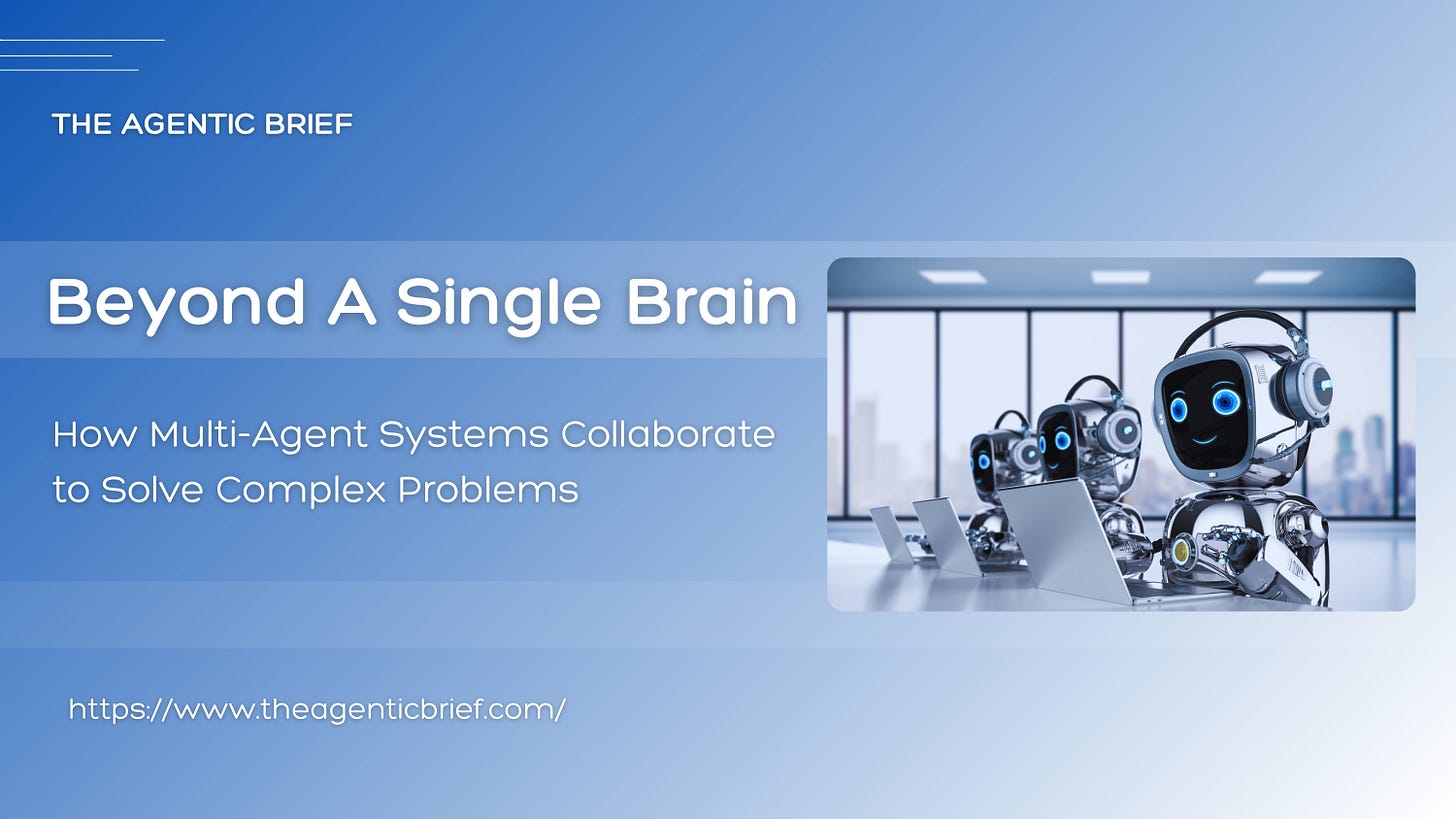Beyond a Single Brain: How Multi-Agent Systems Collaborate to Solve Complex Problems
A technical deep dive into the communication, role assignment, and orchestration that power the next generation of AI.
Introduction: The Limits of a Solo Act
Imagine asking a single brilliant engineer to single-handedly build and launch a rocket. They’d need to be an expert in propulsion, materials science, avionics, and software. It’s an impossible ask. This is the fundamental limitation of a single, monolithic AI agent. While powerful, it can become a “jack of all trades, master of none” when faced with a multi-faceted problem.
The paradigm shift is here: Multi-Agent Systems (MAS). Instead of one AI trying to do everything, we create a team of specialized AI agents, each an expert in its domain, collaborating under a central orchestrator to achieve a common goal. This is the architectural leap from a solo performer to a world-class orchestra.
This article is a technical deep dive into how these autonomous entities collaborate, focusing on the three pillars of any effective team: Communication, Role Assignment, and Orchestration.
The Three Pillars of Effective Multi-Agent Collaboration
1. Role Assignment: Building a Specialized Team
The first step is moving from a general-purpose prompt to defining specialized roles. This is where you move from “Hey, AI, build me a marketing plan” to assembling a team with a Product Manager, a Content Strategist, and a Data Analyst.
Technical Implementation: This is achieved through system prompts that lock an agent into a specific persona, context, and set of capabilities.
Example: Your
CodeReviewAgenthas a system prompt that states: “You are a senior software engineer specializing in Python and security. Your role is to analyze code for bugs, security vulnerabilities, and performance issues. You do not generate new code.”Why it works: Specialization leads to higher quality outputs. A narrower focus allows for more precise instructions and reduces the chance of the agent hallucinating outside its domain.
2. Communication: The Language of Collaboration
Agents cannot work in silos. They need a structured way to share information, request help, and pass results. This isn’t just a casual chat; it’s a structured data exchange.
Technical Implementation: Communication is typically managed through a central controller or a framework like LangGraph or CrewAI.
Shared State: A common “whiteboard” or shared memory object is used. After the
DataAnalystagent finishes its analysis, it writes a summary to this shared state.Structured Messages: Agents don’t just talk; they pass structured data. The
DataAnalystmight pass a JSON object like{”sales_trend”: “upward”, “key_driver”: “feature_x”, “data_quality_score”: 0.95}to theReportWriteragent.Why it works: Structured communication prevents misinterpretation and ensures that the output of one agent becomes clean, machine-readable input for the next.
3. Orchestration: The Conductor of the Workflow
Orchestration is the brain of the operation. It defines the workflow the sequence of actions, the conditions for handoffs, and the rules for handling failures. It decides what happens when.
Technical Implementation: This is often modeled as a graph-based workflow.
Sequential Flow:
Agent A → Agent B → Agent C. (First research, then write, then review).Conditional Flow:
Agent A → (If condition X, go to Agent B; If condition Y, go to Agent C). ASupportAgentmight route a complex hardware issue to aSpecialistHardwareAgentand a billing question to aBillingAgent.Parallel Flow:
Agent AandAgent Bwork simultaneously on different sub-tasks, and their results are synthesized byAgent C.Why it works: Orchestration introduces reliability, efficiency, and fault tolerance. The system can handle complex, real-world processes that are never purely linear.
A Practical Scenario: From Bug Report to Fix
Let’s see how this works in practice. The goal: Automatically handle a bug report.
Orchestrator receives a new bug ticket: “App crashes when user clicks ‘export’.”
Role Assignment: The orchestrator triggers the
BugTriageragent.Communication: The
BugTriageranalyzes the ticket, classifies it as a “backend, data-export” issue, and writes this classification to the shared state.Orchestration: Based on the “backend” label, the orchestrator routes the task to the
BackendDeveloperAgent.Communication: The
BackendDeveloperAgentpulls the bug context, writes a fix, and passes the code to theCodeReviewAgent.Orchestration & Communication: The
CodeReviewAgentapproves the fix. The orchestrator then triggers a finalQAReportAgentto generate a summary of the action taken.
This entire, complex workflow happens autonomously, mimicking a high-functioning human team.
Frequently Asked Questions (FAQ)
Q: Isn’t this more expensive than using one powerful model?
Initially, it can be, due to multiple API calls. However, the long-term benefits higher quality outputs, reduced errors, and the ability to use smaller, cheaper, fine-tuned models for specific tasks often lead to a better return on investment and lower operational costs than constantly retrying with a single, expensive, general-purpose model.
Q: How do you handle agents disagreeing with each other?
This is a key function of the orchestrator. The workflow can include a “tie-breaker” or “manager” agent whose role is to resolve conflicts. Alternatively, the orchestrator can be programmed to default to a specific action or escalate to a human when consensus isn’t reached.
Q: Is this just automation, or is it truly “intelligent”?
It’s a form of orchestrated intelligence. While each agent may be following its instructions, the system as a whole exhibits emergent, intelligent behavior problem-solving, adaptation, and complex task completion that no single agent could achieve alone. This is the core of Agentic AI.
Q: What’s the biggest technical challenge in building these systems?
Managing state and context across long-running conversations and ensuring robust error handling so the entire system doesn’t fail because one sub-task had an issue. Debugging a graph of interacting agents is also significantly more complex than debugging a single prompt.
Ready to stop prototyping and start architecting?
The shift from single agents to multi-agent systems is the most important architectural decision you’ll make in your AI journey. It’s the difference between building a feature and building a foundational capability.
At TheAgenticLearning.com, we provide the frameworks, case studies, and technical guides to help you and your team design, build, and deploy robust Multi-Agent Systems.
Visit our website to explore our resources and join the community of builders shaping the future of Agentic AI.


